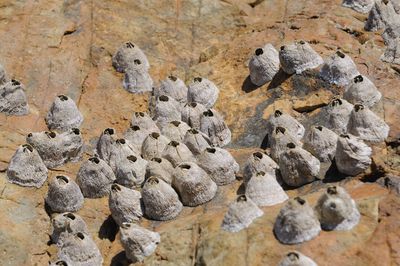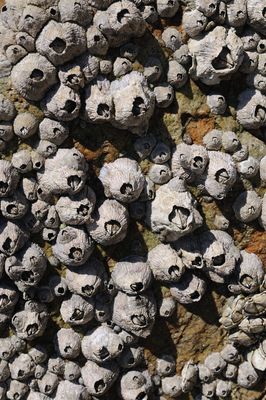Marine Parks
|
The Oddities on the Rock (II) It is easy to find some small volcanoes at the pier or rocks on shores. Actually, these volcanoes are barnacles, a common organism in the intertidal zone. Though it is often misjudged as “clams” owing to their appearance, it belongs to the class Crustacea, the same class as crabs and shrimps. Tetraclita japonica is one of the most common barnacle species in Hong Kong. It possesses a pale grey calcareous shell-like structure, which looks like a small volcano. The “shell” is made up of various kinds of calcium compounds, with an opening at the centre of the shell. The opening is made up of movable plates. When water current passes the barnacle, it will open the plates and extend its feathery legs to capture the planktons from water. During low tide, barnacle would seal the opening by the plates to avoid water loss and protect itself from predators. Most of the barnacles are hermaphrodites; yet, during mating season, it could only act as either male or female. Barnacle generates its eggs once a year only. When the eggs get mature, the barnacles release a kind of chemical to attract the male barnacle to fertilize the eggs by putting its long male reproductive organ into the female body. The larvae would leave its mother and spend some time drifting with planktons. When it finds a suitable substrate, it will glue itself onto the surface and start to grow. Barnacles are regarded as a menace to the global shipping industry. They glue themselves at the bottom of ships and create great resistance when the ships navigate. Thus, great amount of money and resources are required for extra fuel and deterring the barnacles. However, some barnacle species are regarded as precious seafood in Japan and Spain, which generates the local barnacles’ cultivation industry in these countries. ------------- Interesting facts
|
||||
|
||||

